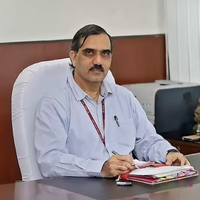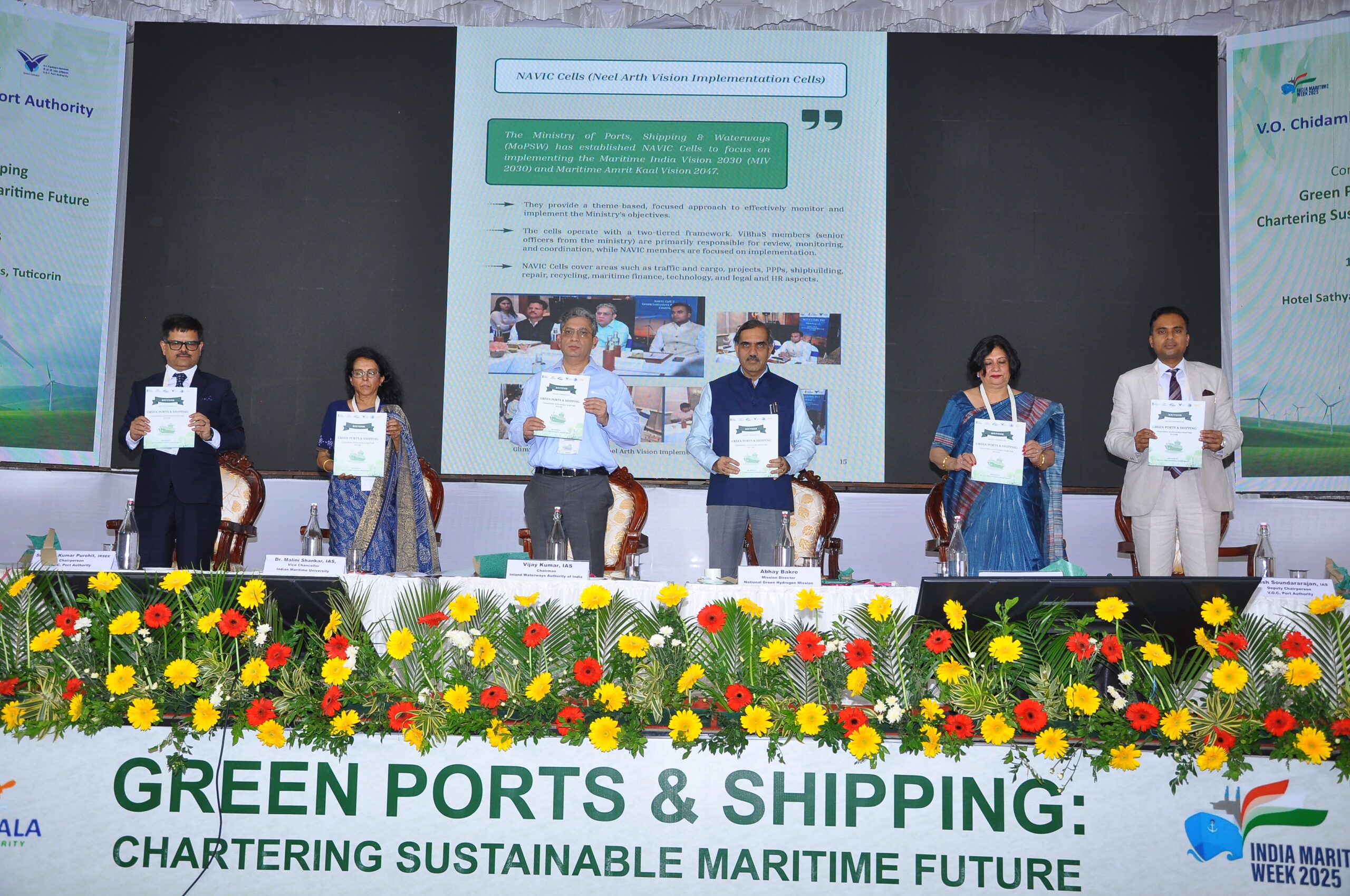

India’s maritime sector is at a monumental juncture poised between tradition and transformation, balancing growth and responsibility. In alignment with the national vision for a green economy of Hon’ble Prime Minister Shri Narendra Modi, and in the leadership of Cabinet Minister, MoPSW Hon’ble Shri Sarbananda Sonowal, the V.O. Chidambaranar Port Authority, Tuticorin, in collaboration with Bharat Pravah- IGPP, hosted a landmark conference with the theme: ‘Green Ports & Shipping – Chartering a Sustainable Maritime Future.’ This one-day conference, in the run up to the India Maritime Week,2025, organised under the aegis of the Ministry of Ports, Shipping & Waterways and curated by NAVIC Cell–3 (Green Initiatives and Pollution Control), brings together distinguished stakeholders. From top government functionaries and port authorities to environmental researchers, green finance experts, private infrastructure developers and innovators in clean energy. The conference facilitated an honest, ambitious and forward-looking dialogue on sustainable maritime development.

On this occasion, Union Minister of Ports, Shipping and Waterways Shri Sarbananda Sonowal said ‘The Indian maritime sector is undergoing a remarkable transformation, not merely as a gateway for commerce but as a champion of climate resilience and environmental stewardship. Guided by Prime Minister Modi’s ambitious Maritime India Vision 2030, our ports are embracing sustainable practices globally.’
Shri Shantanu Thakur, Minister of State for Ports, Shipping and Waterways said ‘working on the vision of Prime Minister Shri Narendra Modi comprehensive action plans have been charted to implement Green initiatives outlined in the Maritime India Vision 2030 and the Harit Sagar Guidelines, aligning with the Hon’ble Prime Minister’s Panchamrit goals to achieve net-zero emissions by 2070.


In his virtual special address Shri T.K. Ramachandran, IAS, Secretary, Ministry of Ports, Shipping and Waterways (MoPSW) said, ‘we need to develop experience with handling green hydrogen and associated technologies’
In his inaugural address, Inland Waterways Authority of India Chairman Shri Vijay Kumar emphasised the need for sustainability in India’s maritime sector. He further stated: ‘To realise India’s 2070 net-zero target, the NAVIC Cell of the Ministry is coordinating various efforts to create environmentally friendly inland waterways across India in a comprehensive manner. We are working on many fronts to reduce carbon emissions: we are transitioning towards renewable energy, shifting to energy-efficient equipment, promoting green fuels such as LNG, ammonia, and hydrogen, and upgrading ports’ equipment.’








Shri Susanta Kumar Purohit Chairperson, V.O.C Port Authority
Shri Abhay Bhakre, IRSEE, Mission Director NGHM
Dr. Vibha Dhawan DG, TERI
Dr. Malini Shankar, VC, IMU
Shri Vijay Kumar, IAS, Chairman, Inland Waterways Authority of India and Nodal officer NAVIC Cell- 3
Shri Rajesh Soundararajan, IAS, Deputy Chairperson, V.O.C Port Authority
Shri D.P. Dash, IRSEE, Principal Advisor, VOC Port Authority

On the occasion of the conference, a commemorative souvenir was released to mark the important gathering. It was released by Shri TK Ramachandran IAS Secretary, MoPSW. It captures key insights, expert reflections, and ongoing efforts towards creating a sustainable and environmentally responsible maritime future of India. It serves not only as a record of the event but also as a resource to inspire continued dialogue and innovation in the green transformation of ports and shipping sectors.
The inaugural session sets the stage for a transformative dialogue by emphasizing the urgency and opportunity in decarbonizing maritime operations. Senior dignitaries and subject-matter experts will explore strategies to reduce greenhouse gas emissions in port ecosystems and shipping corridors.
This forward-looking session envisioned India’s maritime sector by 2035, focusing on the adoption of low-emission fuels such as LNG, methanol and green hydrogen. Discussions covered the development of green shipping corridors, dedicated bunkering and refueling hubs, and port-based renewable energy systems. This session articulated a clear roadmap for operationalising Net Zero goals in the maritime space, integrating innovation, international cooperation, and robust capacity-building as cornerstones of transformation.
This session focused on unlocking the financial and regulatory architecture required to scale sustainable maritime infrastructure. With panelists from the renewable energy sector, global port developers, and strategic policy circles, the session highlighting following themes:
The success of decarbonisation hinges on a powerful interplay between three key pillars: technology, finance and regulation.
India has a unique opportunity to become a net supplier of green fuels thanks to its abundant solar, wind and water resources. It is producing green hydrogen at ₹56/kg and green ammonia under $800/tonne, costs that are far below global averages. This potential is further strengthened by strategic investments, with major ports deploying over 75.66 GW of renewable energy in FY 2023–24.
A resilient, competitive and green logistics ecosystem hinges on the integrated development of all modes, with multimodal connectivity forming the cornerstone of India’s logistics competitiveness.
While investments are being made in future fuels like LNG, hydrogen, ammonia and methanol currently there is no global clarity yet on which will dominate. Midstream infrastructure, pipelines, storage, barging routes and port readiness, is critical for scaling the hydrogen economy.
A successful green transformation of ports hinges on three pillars: building a port-level ecosystem with green energy suppliers and revised PPP frameworks, coordinating seaside efforts for older, low-margin vessels and decarbonising landside logistics, especially the diesel truck fleet.
Ships have a lifespan of 20-25 years, due to the existing uncertainty shipowners are hesitant to invest in new technology ships. Tiered measures to support transition in short-, mid- and long-term horizons are being adopted by shipping companies.
Green transition needs trillions in funding. While government funding is essential it is currently insufficient, private sector capital must be unlocked through state facilitation.
ESG compliance is increasingly becoming a prerequisite for investment. ESG and sustainability practices need to be institutionalised in existing infrastructure and not merely remain as one time exercise.
The tendering and procurement process must not solely focus on costs for competitive bidding but also integrate green clauses which can influence the final tender allotment.
Ports must incorporate ecological resilience, such as mangrove conservation, into infrastructure planning to safeguard long-term investments and ensure that national ambitions translate into on-ground results.
Capacity building is essential for adoption of new age technologies in the shipping industry. Seafarers, engineers, technicians, policy makers all need to be educated.
Environmental costs must be internalised through carbon taxes on high-emission modes and enhance energy efficiency across the entire logistics chain, from shipping to ports and equipment. Furthermore, policy and market mechanisms such as GST rebates and tax incentives for green technologies must actively incentivise sustainable choices.
Waterways, despite being the most affordable mode of cargo transport remain underutilised. However, this is changing, with a CAGR of over 20% over the past year. Businesses that adopt this low-carbon logistics mode can generate carbon credits, which in turn can significantly improve their Internal Rate of Return (IRR).
The transition to low-emission fuels is complex, with methanol emerging as a near-term option amid evolving IMO classifications, while ammonia awaits regulatory clarity. Rising operational and capital costs underscore the need for careful planning, as ships increasingly adopt automation and CO₂ intensity monitoring to meet compliance demands.
There needs to be a synergy among the various national and international green standards to realise the export potential of green fuels.
In a thoughtful gesture to balance the intensity of the day’s high-powered sessions, the VOC Port Authority hosted a cultural evening that offered a refreshing contrast to the technical discourse. The cultural program featured soulful performances by in-house talent from the VOC Port family, showcasing the vibrant local traditions of the region. Through captivating music, graceful dance and artistic expressions rooted in Tamil Nadu’s rich cultural heritage, the performers brought a sense of warmth, community and celebration to the gathering. This closing segment not only celebrated the spirit of the VOC Port but also served as a moment of connection and relaxation for all delegates. It was a fitting culmination to a day of learning, collaboration and forward-looking vision as the participants took with them not just policy takeaways but also cherished memories of cultural richness and camaraderie.